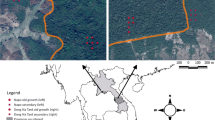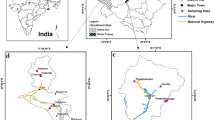Abstract
This study assesses the effects of human disturbance on: (1) floristic composition, diversity, and plant community types; and, (2) the regeneration potential of woody species in the Debrelibanos Monastery forest patch in the North Showa zone of Oromia National Regional State, Ethiopia. Fifty sample quadrats were placed on parallel transect lines along altitudes in the forest using a systematic sampling design. Quadrats of 1 m2, 100 m2 and 400 m2 were used for recording herbaceous/seedling, sapling and tree species, respectively, with symptoms of different human disturbance effects. One hundred and thirteen species belonging to 52 families were recorded in the forest patch. The results show 459.5 stems ha−1 of tree/shrub species present. Four community types, namely Juniperus procera–Acacia lahai, Carissa spinarum–Acacia abyssinica, Olea europaea subsp. cuspidata–Euphorbia abyssinica and Ficus sur–Allophylus abyssinicus were identified. The overall Shannon–Wiener diversity index was 3.3. The regeneration patterns of some species were poor. Slope, altitude and human activities had significant effects on vegetation patterns and imply that current management practices are not satisfactory to sustain the forest. Unless improved management interventions are made, the sustainability of forest services will be at stake.






Similar content being viewed by others
References
Abera B (2014) Medicinal plants used in traditional medicine by Oromo people, Gimbi District, Southwest Ethiopia. J Ethnobiol Ethnomed 10(4):1–15
Aynekulu EB (2011) Forest diversity in fragmented landscapes of northern Ethiopia and implications for conservation. PhD Thesis, Ecology and Development Series No. 76, Bonn, Germany, pp 1–141. http://hss.ulb.uni-bonn.de/2011/2294/2294a
Bekele T (1994) Phytosociology and ecology of a humid afromontane forest on the Central Plateau of Ethiopia. J Veg Sci 5(1):87–98
Cajo JF, Braak T (1987) The analysis of vegetation-environment relationships by canonical correspondence analysis. Vegetatio 69:69–77
Chojnacky DC, Milton M (2008) Field measurements for forest carbon monitoring, measuring carbon in shrubs. In: Hoover CM (ed) Springer Science + Business Media B.V. pp 45–72. https://link.springer.com/chapter/10.1007/978-1-4020-8506-2_5/
Demie G, Limenih M, Belliethanthan S (2013) Plant community types, vegetation structure and regeneration status of remnant dry afromontane natural forest patch within debrelibanos monastry. Natural Resources and Conservation, Ethiopia, pp 1–24
Dessie G, Kleman J (2007) Pattern and magnitude of deforestation in the South Central Rift Valley Region of Ethiopia. Mt Res Dev 27(2):162–168
Downing AL (2005) Relative effects of species composition and richness on ecosystem properties in ponds. Ecology 86(3):701–715
FAO (2007) State of the world’s forests, Food and Agriculture Organisation of the United Nations, Rome. http://www.fao.org/3/a-a0773e.pdf
Getaneh S, Girma Z (2014) An ethnobotanical study of medicinal plants in Debrelibanos Wereda, Central Ethiopia. Afr J Plant Sci 8(7):366–379
Hadera G (2000) A study on the ecology and management of the Dessa forest in the northeastern escarpment of Ethiopia, Unpublished MSc Thesis, Addis Ababa University
Kelbessa E, Demissew S (2014) diversity of vascular plant taxa of the flora of Ethiopia and Eritrea. Ethiop J Biol Sci 13:37–45
Kent M, Coker P (1992) Vegetation descrption and analysis: a practical approach, England, pp 1–363. https://www.jstor.org/stable/4201426
Lambin EF, Meyfroidt P (2011) Global land use change, economic globalization, and the looming land scarcity. Proc Natl Acad Sci USA 108(9):3465–3472
Lamprecht H (1989) Tropical forest ecosystems and their tree species. In: Siliviculture in Tropics, possibilities and methods for their long-term utilization, Institute of for siliviculture of the University of Gottingen. Technical Cooperation of Federal Republic of Germany, Berlin
Magurran AE (2004) Measuring biological diversity, UK, pp 1–132. https://www2.ib.unicamp.br/profs/thomas/.pdf
Mukhopadhyay D, Tewari TH, Roy SB (2007) Role of community institutions in joint forest management. J Hum Ecol 21:37–42
Naderi H, Sharafatmandrad M (2017) Change of species diversity in vascular plants across ecological species groups. J Rangel Sci 7(2):107–121
Nagy CR, Porder SC, Paulo NB, Mota RQ, Avizdo SN (2015) Structure and composition of altered riparian forests in an agricultural Amazonian landscape. Ecol Appl 25(6):1725–1738
Pare S, Tigabu M, Savadogo P, Ode PC, Ouadba JM (2009) Does designation of protected areas ensure conservation of tree diversity in the Sudanian dry forest of Burkina Faso? Afr J Ecol 48:347–360
Pielou EC (1966) Species diversity and pattern diversity in the study of ecological succession. J Theor Biol 10:370–383
Quackenbushg L, Hopkins P, Kinn G (2000) Developing forestry products from high resolution digital aerial imagery. Photogramm Eng Remote Sens 66(11):1337–1346
Sanchez-Jardon L, Acosta B, del Pozo A, Casado MA, Ovalle C, Elizalde HF, Hepp C, de Miguel JM (2010) Grassland productivity and diversity on a tree cover gradient in Nothofagus pumilio in NW Patagonia. Agr Ecosyst Environ 137:213–218
Senbeta F (2006) Biodiversity and ecology of afromontane rainforests with wild coffee arabica L. Populations in Ethiopia, PhD thesis, Ecology and Development Series, 38, University of Bonn, ZEF Bonn, Germany, pp 1–152. https://www.zef.de/fileadmin/webfiles/…ecology_development/ecol_dev_38_text.pdf
Shiferaw W, Lemenih M, Gole TWM (2018) Analysis of plant species diversity and forest structure in Arero dry Afromontane forest of Borena zone, South Ethiopia. Trop Plant Res 5(2):129–140
Swaine MD, Hawthorne WD, Bongers F, Toledo Aceves M (2005) Climbing plants in Ghanaian forests. In: Bongers F, Parren MPE, Traore D (eds) Forest climbing plants of West Africa. diversity, ecology and management, CAB International, Wallingford, Oxfordshire, UK, pp 93–107. https://www.researchgate.net/…Swaine/…Climbing_plants_in_Ghanaian_forests/
Swamy PS, Sundarapandian SM, Chandrasekar P, Chandrasekaran S (2000) Plant species diversity and tree population structure of a humid tropical forest in Tamil Nadu, India. Biodivers Conserv 9:1643–1669
Tadele D, Lulekal E, Damtie D, Assefa A (2014) Floristic diversity and regeneration status of woody plants in Zengena Forest, a remnant montane forest patch in northwestern Ethiopia. J For Res 25(2):329–336
Tekle K, Backeus I, Skuglund J, Woldu Z (1997) Vegetation on hill slopes of Wello, Ethiopia: degradation and regeneration. Nord. J Bot 17(5):483–493
Teshome M (2014) Population growth and cultivated land in Rural Ethiopia: land use dynamics, access, farm size, and fragmentation. Resour Environ 4(3):148–161
Thies C, Romsoman G, Cotter J, Meaden S (2011) Intact forest landscapes: why it is crucial to protect them from industrial exploitation. Green Space Research Laboratories Technical Note No. 5, Greenpeace International, 1066 AZ Amsterdam, The Netherlands, pp 1–20. http://www.greenpeace.org/eu-unit/en/campaigns/forests/
Van der Maarel E (1979) Transformation of cover abundance in phytosociology and its effects on community similarity. Vegetation 39:97–114
Vivero JL, Kelbessa E, Demissew S (2005) The red list of endemic trees and shrubs of Ethiopia and Eritrea. In: Magin G, Oldfield S (eds), ISBN: 1 903703 19 0, Fauna & Flora International, Cambridge, UK, pp 1–28. https://www.academia.edu/1440709/
Wassie AE (2007) Ethiopian church forests: opportunities and challenges for restoration. PhD thesis. Wageningen Univeristy, Wageningen, The Netherlands, ISBN: 978-90-8504-768-1, pp 1–212
Woldu Z (2017) Comprehensive analysis of vegetation and ecological data-basic, concepts, methods. Addis Ababa University, Addis Ababa University Press, Rehobot Printing, Addis Ababa, Ethiopia, pp 1–482. www.aau.edu.et/offices/v_president-office/
Woldu Z, Backeus I (1991) The shrub land vegetation in western shewa, ethiopia and its possible recovery. J Veg Sci 2:173–180
Woldu Z, Feoli E, Nigatu L (1989) Partitioning an elevation gradient of vegetation from southeastern ethiopia by probabilistic methods. Vegetation 81:189–198
Worku A, Teketay D, Lemenih M, Fetene M (2012) Diversity, regeneration status, and population structures of gum and resin producing woody species in Borana, Southern Ethiopia. For Trees Livelihoods 21(2):85–96
World Reference Base for Soil Resources (WRB) (2006) World reference base for soil resources: a framework for international classification, correlation and accumulation. World Soil Resource No. 103. 2nd ed., FAO, Rome, pp 1–145. http://www.fao.org/3/a-a0510e.pdf
Acknowledgements
The first author is thankful to Mr. Bahiru Mekonnen and Mr. Kaletsidik Yifru for their assistance during data collection. Special thanks also go to Abba Amdemichael Delelegn for hosting us and providing shelter during data collection. All the members of the National Herbarium of Addis Ababa University are appreciated for their facilitation of materials in the herbarium.
Author information
Authors and Affiliations
Corresponding author
Additional information
Project funding
The work was supported by Arba Minch and Addis Ababa Universities.
The online version is available at http://www.springerlink.com
Corresponding editor: Zhu Hong.
Electronic supplementary material
Below is the link to the electronic supplementary material.
Rights and permissions
About this article
Cite this article
Shiferaw, W., Bekele, T. & Demissew, S. Anthropogenic effects on floristic composition, diversity and regeneration potential of the Debrelibanos Monastery forest patch, central Ethiopia. J. For. Res. 30, 2151–2161 (2019). https://doi.org/10.1007/s11676-018-0782-7
Received:
Accepted:
Published:
Issue Date:
DOI: https://doi.org/10.1007/s11676-018-0782-7




